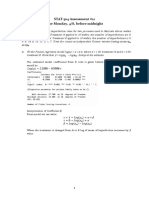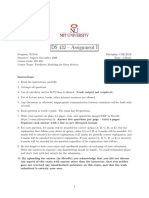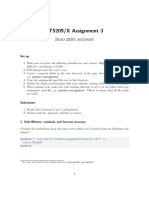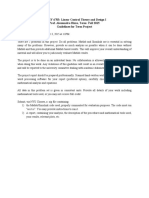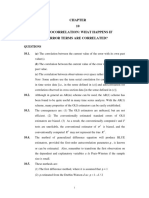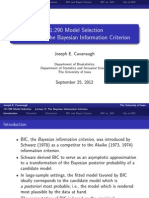F 11 Final
Uploaded by
deba_subiF 11 Final
Uploaded by
deba_subiSTAT 520
FALL 2011 FINAL
GROUND RULES:
This exam contains two parts:
Part 1. Multiple Choice (50 questions, 1 point each)
Part 2. Problems/Short Answer (10 questions, 5 points each)
The maximum number of points on this exam is 100.
Print your name at the top of this page in the upper right hand corner.
IMPORTANT: Although not always stated, it is understood that {et } is a zero
mean white noise process with var(et ) = e2 .
This is a closed-book and closed-notes exam. You may use a calculator if you wish.
Cell phones are not allowed.
Any discussion or otherwise inappropriate communication between examinees, as
well as the appearance of any unnecessary material, will be dealt with severely.
You have 3 hours to complete this exam. GOOD LUCK!
HONOR PLEDGE FOR THIS EXAM:
After you have nished the exam, please read the following statement and sign your name
below it.
I promise that I did not discuss any aspect of this exam with anyone other than
the instructor, that I neither gave nor received any unauthorized assistance
on this exam, and that the work presented herein is entirely my own.
PAGE 1
STAT 520
FALL 2011 FINAL
PART 1: MULTIPLE CHOICE. Circle the best answer. Make sure your answer is
clearly marked. Ambiguous responses will be marked wrong.
1. Which of the following processes is stationary?
(a) An MA(1) process with = 1.4
(b) Yt = 12.3 + 1.1Yt1 + et
(c) IMA(1,1)
(d) Yt = 0 + 1 t + et
2. Which statement about an AR(2) process is always true?
(a) The process is invertible.
(b) The process is stationary.
(c) The theoretical ACF k = 0 for all k > 2.
(d) The theoretical PACF kk decays exponentially or according to a sinusoidal pattern
as k gets large.
3. Suppose that we have observations from an MA(1) process with = 0.9. Which of
the following is true?
(a) The scatterplot of Yt versus Yt1 will display a negative linear trend and the scatterplot of Yt versus Yt2 will display a negative linear trend.
(b) The scatterplot of Yt versus Yt1 will display a positive linear trend and the scatterplot of Yt versus Yt2 will display a positive linear trend.
(c) The scatterplot of Yt versus Yt1 will display a negative linear trend and the scatterplot of Yt versus Yt2 will display a random scatter of points.
(d) The scatterplot of Yt versus Yt1 will display a positive linear trend and the scatterplot of Yt versus Yt2 will display a random scatter of points.
4. Suppose that we have observed the time series Y1 , Y2 , ..., Yt . If the forecast error
et (l) = Yt+l Ybt (l) has mean zero, then we say that the MMSE forecast Ybt (l) is
(a) stationary.
(b) unbiased.
(c) consistent.
(d) complementary.
5. What did we discover about the method of moments procedure when estimating
parameters in ARIMA models?
(a) The procedure gives reliable results when the sample size n > 100.
(b) The procedure gives unbiased estimates.
(c) The procedure should not be used when models include AR components.
(d) The procedure should not be used when models include MA components.
PAGE 2
STAT 520
FALL 2011 FINAL
6. What is an AR characteristic polynomial?
(a) A function that can be used to assess normality
(b) A function of that can be used to characterize invertibility properties.
(c) A function that can be used to characterize stationary properties.
(d) All of the above.
7. Which statement about MMSE forecasts in stationary ARMA models is true?
(a) If Ybt (l) is the MMSE forecast of ln Yt+l , then eYbt (l) is the MMSE forecast of Yt+l .
(b) As the lead time l increases, Ybt (l) will approach the process mean E(Yt ) = .
(c) As the lead time l increases, var[Ybt (l)] will approach the process variance var(Yt ) = 0 .
(d) All of the above are true.
8. If {Yt } follows an IMA(1,1) process, then {Yt } follows a(n)
(a) ARI(1,1)
(b) MA(1)
(c) IMA(2,1)
(d) ARIMA(0,1,2)
process.
Use the R output below to answer Questions 9 and 10.
> data.ar1.fit = arima(data,order=c(1,0,0),method=ML)
> data.ar1.fit
Coefficients:
ar1 intercept
0.4796
179.4921
s.e. 0.0565
0.4268
sigma^2 estimated as 6.495: log likelihood = -126.24, aic = 296.48
9. Concerning the output above, which statement is true?
(a) The AR(1) parameter estimate b is statistically dierent from zero.
(b) This process has mean zero.
(c) The positive AIC means that an AR(1) model is not adequate.
(d) All of the above.
10. If you were going to overt this model for diagnostic purposes, which two models
would you t?
(a) IMA(1,1) and ARMA(2,2)
(b) ARMA(1,1) and AR(2)
(c) ARMA(1,2) and ARI(1,1)
(d) IMA(1,1) and ARI(2,1)
PAGE 3
STAT 520
FALL 2011 FINAL
11. We used R to generate a white noise process. We then calculated rst dierences
of this white noise process. What would you expect the sample ACF rk of the rst differences to look like?
(a) Most of the rk estimates should be close to zero, possibly with the exception of a
small number of estimates which exceed the white noise bounds when k is larger.
(b) The rk estimates will decay very, very slowly across k.
(c) The r1 estimate should be close to 0.5 and all other rk estimates, k > 1, should be
small.
(d) It is impossible to tell unless we specify a distributional assumption for the white
noise process (e.g., normality).
12. True or False. The use of an intercept term 0 has the same eect in stationary
and nonstationary ARIMA models.
(a) True
(b) False
13. The augmented Dickey-Fuller unit root test can be used to test for
(a) normality.
(b) independence.
(c) stationarity.
(d) invertibility.
14. An observed time series displays a clear upward linear trend. We t a straight line
regression model to remove this trend, and we notice that the residuals from the straight
line t are stationary in the mean level. What should we do next?
(a) Search for a stationary ARMA process to model the residuals.
(b) Perform a Shapiro-Wilk test.
(c) Calculate the rst dierences of the residuals and then consider tting another regression model to them.
(d) Perform a t-test for the straight line slope estimate.
15. Excluding the intercept 0 and white noise variance e2 , which model has the largest
number of parameters?
(a) ARIMA(1, 1, 1) (2, 0, 1)12
(b) ARMA(3,3)
(c) ARMA(1, 1) (1, 2)4
(d) ARIMA(2,2,3)
PAGE 4
STAT 520
FALL 2011 FINAL
16. In performing diagnostics for an ARMA(1,1) model t, I see the following output in
R:
> runs(rstandard(data.arma11.fit))
$pvalue
[1] 0.27
How do I interpret this output?
(a) The standardized residuals seem to be well modeled by a normal distribution.
(b) The standardized residuals are not well represented by a normal distribution.
(c) The standardized residuals appear to be independent.
(d) We should probably consider a model with either p > 1 or q > 1 (or both).
17. True or False. If {Yt } is a stationary process, then {Yt } must be stationary.
(a) True
(b) False
18. A 95 percent condence interval for the Box Cox transformation parameter
is (0.77, 1.41). Which transformation is appropriate?
(a) Square root
(b) Square
(c) Log
(d) Identity (no transformation)
19. What is the name of the process dened by
(1 + 0.6B)(1 B)Yt = (1 0.9B)2 et ?
(a) ARIMA(1,1,2)
(b) ARIMA(2,1,1)
(c) ARIMA(1,2,1)
(d) ARIMA(2,0,1)
20. If an AR(1)12 model is the correct model for a data set, which model is also mathematically correct?
(a) AR(1)
(b) AR(12)
(c) AR(11)
(d) ARMA(1,12)
PAGE 5
STAT 520
FALL 2011 FINAL
21. In Chapter 3, we discussed the use of regression to detrend a time series. Two models
used to handle seasonal trends were the cosine-trend model and the seasonal means
model. Which statement is true?
(a) With monthly data (so that the number of seasonal means is 12), the cosine trend
model is more parsimonious.
(b) Standardized residuals from the cosine trend model t will be normally distributed
if the process is truly sinusoidal.
(c) Dierencing should be used before tting a seasonal means model.
(d) All of the above are true.
22. When we used least squares regression to t the deterministic trend regression model
Yt = 0 + 1 t + Xt in Chapter 3, the only assumption we needed for the least squares
estimators b0 and b1 to be unbiased was that
(a) {Xt } has constant variance.
(b) {Xt } is a white noise process.
(c) {Xt } has zero mean.
(d) {Xt } is normally distributed.
23. If {Yt } is an ARI(1,1) process, then what is the correct model for {Yt }?
(a) Random walk with drift
(b) AR(1)
(c) IMA(2,1)
(d) None of the above
24. For a stationary ARMA(p, q) process, when the sample size n is large, the sample
autocorrelations rk
(a) follow an MA(1) process.
(b) are approximately normal.
(c) are likely not to be statistically signicant from zero.
(d) have variances which decrease as k gets larger.
25. What is the main characteristic of an AR(1) process with parameter = 0.2?
(a) The mean of the process is equal to 0.2.
(b) The variance of the process is equal to (0.2)2 = 0.04.
(c) The autocorrelation function k exhibits a slow decay across lags.
(d) None of the above.
PAGE 6
STAT 520
FALL 2011 FINAL
26. Consider the process
Yt Yt1 = et 0.5et1 .
How is this process written using backshift notation?
(a) (1 B)Yt = (1 0.5B)et
(b) BYt = (1 0.5B)et
(c) B(Yt Yt1 ) = 0.5Bet
(d) None of the above.
27. What is the name of the process identied in Question #26?
(a) IMA(2,2)
(b) IMA(1,1)
(c) ARI(1,1)
(d) None of the above.
28. In class, we proved that the autocorrelation function for a zero-mean random
walk Yt = Yt1 + et is equal to
t
k =
,
t+k
for k = 1, 2, ...,. Which of the following statements is true?
(a) This process is stationary.
(b) The variance of this process approaches 0 = 1.
(c) corr(Y1 , Y2 ) is larger than corr(Y99 , Y100 ).
(d) None of the above.
29. Why is invertbility so important?
(a) If a process is not invertible, residuals can not be calculated for diagnostics purposes.
(b) If a process is not invertible, MMSE forecasts can not be determined uniquely.
(c) If a process is not invertible, we can not use the ACF, PACF, and EACF for model
specication.
(d) All of the above.
30. We used the Bonferroni criterion for judging a standardized residual (from an
ARIMA model t) as an outlier. What essentially does this mean?
(a) We look at the mean of each residual and take the largest one as an outlier.
(b) Each residual is compared to z0.025 1.96, and all those beyond 1.96 (in absolute
value) are declared outliers.
(c) We perform an intervention analysis and determine if the associated parameter estimate is signicant.
(d) None of the above.
PAGE 7
STAT 520
FALL 2011 FINAL
31. I have t the following model:
(1 B)(1 B 4 )(1 0.43B 4 )Yt = (1 + 0.22B)(1 + 0.88B 4 )et .
Which model does this represent?
(a) ARIMA(1, 1, 1) ARIMA(1, 0, 1)4
(b) ARIMA(0, 1, 1) ARIMA(1, 1, 1)4
(c) ARIMA(1, 1, 1) ARIMA(1, 0, 1)4
(d) ARIMA(0, 2, 1) ARIMA(1, 1, 1)4
32. What statement about the seasonal MA(2)12 model is true?
(a) It is stationary.
(b) It is invertible.
(c) Its ACF k is nonzero when k = 1 and k = 2; otherwise, k = 0.
(d) Its PACF kk is nonzero only when k = 12 and k = 24.
33. Which process is not stationary?
(a) White noise
(b) (1 0.3B)Yt = (1 B)et
(c) The rst dierence of a ARIMA(1,1,1) process with = 1.5 and = 0.5
(d) An AR(2) process whose AR characteristic polynomial roots are x = 0.8 0.9i
34. If an ARIMA model is correctly specied and our estimates are reasonably close to
the true parameters, then the residuals should behave roughly like an iid normal white
noise process. Why do we say roughly?
(a) R can not calculate residuals at early lags, so it is impossible to tell.
(b) The mean of the residuals at early lags is not zero (as in a white noise process).
(c) The autocorrelations of residuals are slightly dierent than those of white noise at
early lags.
(d) None of the above.
35. The length of a prediction interval for Yt+l computed from tting a stationary
ARMA(p, q) model generally
(a) increases as l increases.
(b) decreases as l increases.
(c) becomes constant for l suciently large.
(d) tends to zero as l increases.
PAGE 8
STAT 520
FALL 2011 FINAL
36. Under normality, what is a valid interpretation of the partial autocorrelation kk ?
(a) It measures the autocorrelation in the data Y1 , Y2 , ..., Yn after taking kth dierences.
(b) It is the correlation between Yt and Ytk , after removing the linear eects of the
variables between Yt and Ytk .
(c) It equals the variance of the large-sample distribution of rk .
(d) It is the correlation of the rst k residuals in an ARIMA model t.
37. Recall that a models BIC is given by
BIC = 2 ln L + k ln n,
where ln L is the natural logarithm of the maximized likelihood function and k is the
number of parameters in the model. Which statement is true?
(a) The smaller the BIC, the better the model.
(b) When compared to the AIC, BIC oers a stier penalty for models with a large
number of parameters.
(c) Both (a) and (b) are true.
(d) Neither (a) nor (b) are true.
38. True or False. In a stationary ARMA(p, q) model, maximum likelihood estimators of model parameters (i.e., the s and the s) are approximately normal in large
samples.
(a) True
(b) False
39. In the acronymn ARIMA, what does the I stand for?
(a) Independence
(b) Integrated
(c) Intraclass
(d) Irreversible
40. The rst dierence of a stationary AR(1) process can be expressed as
(a) a white noise process.
(b) an invertible MA(1) process.
(c) a nonstationary AR(2) process.
(d) a stationary ARMA(1,1) process.
PAGE 9
STAT 520
FALL 2011 FINAL
41. You have an observed time series that has clear nonconstant variance and a sharp
linear trend over time. What should you do?
(a) Display the ACF, PACF, and EACF of the observed time series to look for candidate
models.
(b) Split the data set up into halves and then t a linear regression model to each part.
(c) Try dierencing the series rst and then try a transformation to stabilize the variance.
(d) Try a variance-stabilizing transformation rst and then use dierencing to remove
the trend.
42. During lecture, I recounted a true story where I had asked a fortune teller (in the
French Quarters) to comment on the precision of her predictions about my future. In
what city did this story take place?
(a) New Orleans
(b) Nome
(c) Nairobi
(d) Neverland
43. What was the famous quote we cited from Box?
(a) Going to time series class is like going to church; many attend but few understand.
(b) Modeling time series data is like running over hot coals; do it fast so that it hurts
less.
(c) Detrending time series data is for amateur statisticians.
(d) All models are wrong; some are useful.
44. Suppose that {Yt } is a white noise process and that n = 400. If we performed
a simulation to study the sampling variation of r1 , the lag one sample autocorrelation,
about 95 percent of our estimates r1 would fall between
(a) 0.025 and 0.025
(b) 0.05 and 0.05
(c) 0.1 and 0.1
(d) 0.2 and 0.2
45. What is the stationarity condition for the seasonal AR(1)12 given by
Yt = Yt12 + et ?
(a) 12 < < 12
(b) 1 < < 1
(c) 1/12 < < 1/12
(d) None of the above
PAGE 10
STAT 520
FALL 2011 FINAL
46. What technique did we use in class to simulate the sampling distribution of sample
autocorrelations and method of moments estimators?
(a) Monte Carlo
(b) Bootstrapping
(c) Jackkning
(d) Backcasting
47. True or False. In a stationary ARMA(p, q) process, the MMSE forecast Ybt (l) depends on the MA components only when l q.
(a) True
(b) False
48. The Yule-Walker equations can be used to
(a) assess if standardized residuals from a stationary ARMA(p, q) t are normally distributed.
(b) calculate early residuals for a stationary ARMA(p, q) t.
(c) compute autocorrelations for a stationary ARMA(p, q) process.
(d) determine if a variance-stabilizing transformation is necessary.
49. In the notes, we discussed this quote:
Simulation evidence suggests a preference for the maximum likelihood estimator for small or moderate sample sizes, especially if the moving average
operator has a root close to the boundary of the invertibility region.
In this quote, what is meant by the phrase especially if the moving average operator
has a root close to the boundary of the invertibility region?
(a) the MA characteristic polynomial has roots that are close to zero.
(b) the roots of the MA characteristic polynomial that are all less than one in absolute
value or modulus.
(c) the MA characteristic polynomial has at least one root which is complex.
(d) None of the above.
50. I have monthly time series data {Yt } which display a clear quadratic trend over
time plus a within-year seasonal component. There are no problems with nonconstant
variance. I should consider using a stationary process to model
(a) (1 B)12 (1 B 2 )Yt
(b) (1 B)24 Yt
(c) (1 B)2 (1 B 12 )Yt
(d) (1 B 12 )2 Yt
PAGE 11
STAT 520
FALL 2011 FINAL
PART 2: PROBLEMS/SHORT ANSWER. Show all of your work and explain all
of your reasoning to receive full credit.
1. Suppose that {Yt } is an MA(1)4 process with mean , that is,
Yt = + et et4 ,
where {et } is a zero mean white noise process with var(et ) = e2 .
(a) Find t = E(Yt ) and 0 = var(Yt ).
(b) Show that {Yt } is (weakly) stationary.
PAGE 12
STAT 520
FALL 2011 FINAL
2. Suppose that {et } is zero mean white noise with var(et ) = e2 . Consider the model
Yt = 0.5Yt1 + et 0.2et1 0.15et2 .
(a) Write this model using backshift notation.
(b) Determine whether this model is stationary and/or invertible.
(c) Identify this model as an ARIMA(p, d, q) process; that is, specify p, d, and q.
PAGE 13
STAT 520
FALL 2011 FINAL
3. Suppose that {et } is zero mean white noise with var(et ) = e2 . Consider the deterministic model
Yt = 0 + 1 t + Xt ,
where Xt = Xt1 + et et1 .
(a) Derive an expression for Yt .
(b) What is the name of the process identied by {Yt }? Is {Yt } stationary?
PAGE 14
STAT 520
FALL 2011 FINAL
4. Explain how the sample ACF, PACF, and EACF can be used to specify the orders p
and q of a stationary ARMA(p, q) process.
PAGE 15
STAT 520
FALL 2011 FINAL
5. Suppose that {et } is zero mean white noise with var(et ) = e2 . Consider the random
walk with drift model
Yt = 0 + Yt1 + et .
We have observed the data Y1 , Y2 , ..., Yt .
(a) Show that the minimum mean squared error (MMSE) forecast of Yt+1 is equal to
Ybt (1) = 0 + Yt .
(b) Show that the MMSE forecast of Yt+l satises
Ybt (l) = 0 + Ybt (l 1),
for all l > 1.
PAGE 16
STAT 520
FALL 2011 FINAL
150
100
50
Number of homeruns
200
6. In class, we looked at the number of homeruns hit by the Boston Red Sox each year
during 1909-2010. Denote this process by {Yt }.
1920
1940
1960
1980
2000
Year
I have used R to t the model
(1 B)Zt = et et1 ,
where Zt =
Yt . Here is the output:
> arima(sqrt(homeruns),order=c(0,1,1),method=ML) # maximum likelihood
Coefficients:
ma1
-0.2488
s.e.
0.1072
sigma^2 estimated as 1.437: log likelihood = -161.64, aic = 325.28
Answer the questions below; the next page can be used for your responses.
(a) Why do you think I used the square-root transformation? Why do you think I used
a nonstationary model?
(b) Based on the model that I t (judged to be reasonable during the model specication phase), what do you think the sample ACF of {Zt } looked like? the sample ACF
of {Zt }?
(c) Write an approximate 95 percent condence interval for based on the model t.
Interpret the interval.
PAGE 17
STAT 520
FALL 2011 FINAL
This page is for your responses to Question 6.
PAGE 18
STAT 520
FALL 2011 FINAL
2
1
0
3 2 1
Standardized Residuals
7. I have displayed below the tsdiag output from tting the model in Question 6 to the
Boston Red Sox homerun data.
1920
1940
1960
1980
2000
0.1
0.0
0.2
ACF of Residuals
0.2
Time
10
15
20
15
20
0.0 0.2 0.4 0.6 0.8 1.0
Pvalues
Lag
10
Number of lags
I have also performed the Shapiro-Wilk and runs tests for the standardized residuals; see
the R output below:
> shapiro.test(rstandard(homerun.fit)
W = 0.9884, p-value = 0.5256
> runs(rstandard(homerun.fit))
$pvalue
[1] 0.378
Based on the information available, what do you think of the adequacy of the model t
in Question 6? Use the back of this page if you need extra space.
PAGE 19
STAT 520
FALL 2011 FINAL
200
8. Recall the TB data from our midterm; these data are the number of TB cases (per
month) in the United States from January 2000 to December 2009. Denote this process
by {Yt }. On the midterm, you used regression methods to detrend the data. On this
problem, we will use a SARIMA modeling approach. In the gure below, the TB data
are on the left, and the combined rst dierenced data (1 B)(1 B 12 )Yt are on the
right.
S
O
J
F
MM
J
MJ
A
JA
J
J
A
O F
S J
M
M
A
A
J
J
S F
O
100
1200
1000
S
F JO
O
F
J
S
J
A
J
S
O
MJ
A
MA
J
F
J J
SO
JF
800
N
N
A
J
M
M
J
A
J
J
A M
MJ
S F
SO
A
F
O
S
N
J
O
N
600
Number of tuberculosis cases in US
AM
J
J
A
D
D
400
A
MM
100
Combined first differences
M
A A
J
200
1400
M
MJ
2000
2002
2004
2006
2008
2010
2002
2004
2006
2008
2010
Year
Year
In Question 9, we will t this model to the data:
(1 B)(1 B 12 )Yt = (1 B)(1 B 12 )et .
I have arrived at this (candidate) model from examining the sample ACF and sample
PACF of the combined rst dierences (1 B)(1 B 12 )Yt . Before we get to the model
t, answer the questions below. Use the back of this page if you need extra space.
(a) Why did I work with the combined rst dierences (1 B)(1 B 12 )Yt ?
(b) Assuming that the model above is a reasonable choice, what would you expect the
sample ACF and sample PACF of the combined rst dierences (1 B)(1 B 12 )Yt to
look like?
(c) The model above is a member of the ARIMA(p, d, q) ARIMA(P, D, Q)s class. Identify the values of p, d, q, P , D, Q, and s.
PAGE 20
STAT 520
FALL 2011 FINAL
9. As promised, I used R to t the model stated in Question 8 (using maximum likelihood). Here is the output:
> tb.fit
Coefficients:
ma1
sma1
-0.9182 -0.4406
s.e.
0.0482
0.1098
sigma^2 estimated as 3436:
log likelihood = -589.81,
aic = 1183.63
Therefore, the tted model is given by
(1 B)(1 B 12 )Yt = (1 0.9182B)(1 0.4406B 12 )et .
(a) Rewrite this tted model without using backshift notation and then simplify as much
as possible. I want an equation with only Yt on the left hand side and the rest of the
model equation on the right hand side.
(b) Are the estimates of and statistically dierent from 0? Explain.
(c) Why doesnt R display an intercept term in the output?
PAGE 21
STAT 520
FALL 2011 FINAL
800
600
200
400
Number of TB cases
1000
1200
10. The model I t to the TB data in Question 9 has been declared a very good model
(after doing thorough residual diagnostics and overtting). In the gure below, I have
displayed the MMSE forecasts (with 95 percent prediction limits) for the next 3 years
(Jan 2010 through Dec 2012).
2007
2008
2009
2010
2011
2012
2013
Year
(a) A 95 percent prediction interval for the TB count in January 2012 is (527.7, 863.5).
Interpret this interval.
(b) Which assumption on the white noise terms {et } is crucial for the prediction interval
in part (a) to be valid?
(c) Careful inspection reveals that the prediction limits in the gure above tend to widen
as the lead time increases. Why is this true?
PAGE 22
You might also like
- STAT 504 Assessment #12 Due Monday, 4/8, Before MidnightNo ratings yetSTAT 504 Assessment #12 Due Monday, 4/8, Before Midnight8 pages
- 40 Questions To Test A Data Scientist On Time SeriesNo ratings yet40 Questions To Test A Data Scientist On Time Series26 pages
- Latent Profile Analysis in R: A Tutorial and Comparison To MplusNo ratings yetLatent Profile Analysis in R: A Tutorial and Comparison To Mplus19 pages
- Microprocessors:: PIEAS MS Test (Electronics Portion 2016)No ratings yetMicroprocessors:: PIEAS MS Test (Electronics Portion 2016)6 pages
- Simple Nonlinear Time Series Models For Returns: José Maria GasparNo ratings yetSimple Nonlinear Time Series Models For Returns: José Maria Gaspar10 pages
- Reading 2 Time-Series Analysis - AnswersNo ratings yetReading 2 Time-Series Analysis - Answers63 pages
- Controls Problems For Qualifying Exam - Spring 2014: Problem 1No ratings yetControls Problems For Qualifying Exam - Spring 2014: Problem 111 pages
- David A. Dickey, North Carolina State Univ., Raleigh, NC: Case Studies in Time SeriesNo ratings yetDavid A. Dickey, North Carolina State Univ., Raleigh, NC: Case Studies in Time Series9 pages
- Student Solutions Manual to Accompany Economic Dynamics in Discrete Time, secondeditionFrom EverandStudent Solutions Manual to Accompany Economic Dynamics in Discrete Time, secondedition4.5/5 (2)
- Ecology Letters - 2015 - Mori - Low Multifunctional Redundancy of Soil Fungal Diversity at Multiple ScalesNo ratings yetEcology Letters - 2015 - Mori - Low Multifunctional Redundancy of Soil Fungal Diversity at Multiple Scales11 pages
- Högskolan Dalarna: School of Technology and Business StudiesNo ratings yetHögskolan Dalarna: School of Technology and Business Studies32 pages
- Evaluation of The Irritable Bowel Syndrome Quality of Life IBS-QOL Questionnaire in Diarrheal-Predominant Irritable Bowel Syndrome PatientsNo ratings yetEvaluation of The Irritable Bowel Syndrome Quality of Life IBS-QOL Questionnaire in Diarrheal-Predominant Irritable Bowel Syndrome Patients12 pages
- A "Short" Introduction To Model SelectionNo ratings yetA "Short" Introduction To Model Selection25 pages
- ST3189 - Machine Learning - 2020 Examiners CommentariesNo ratings yetST3189 - Machine Learning - 2020 Examiners Commentaries13 pages
- CFA-Level-II-Formula-Sheet-2025-by-Fabian-MoaNo ratings yetCFA-Level-II-Formula-Sheet-2025-by-Fabian-Moa56 pages
- Autoregressive Distributed Lag (ARDL) ModelsNo ratings yetAutoregressive Distributed Lag (ARDL) Models21 pages
- Mixture of Partial Least Squares Regression ModelsNo ratings yetMixture of Partial Least Squares Regression Models13 pages
- Big_Data_Data_Mining_and_Data_Science_-_George_DimitoglouNo ratings yetBig_Data_Data_Mining_and_Data_Science_-_George_Dimitoglou386 pages
- Gaussian Mixture Models-Based Control Chart Pattern Recognition100% (1)Gaussian Mixture Models-Based Control Chart Pattern Recognition18 pages
- Chapter 11 - Generalized Regression For DOEsNo ratings yetChapter 11 - Generalized Regression For DOEs42 pages
- Machine Learning and Statistical Prediction of Fastball VelocityNo ratings yetMachine Learning and Statistical Prediction of Fastball Velocity8 pages
- McMillen, D. P., & McDonald, J. F. (2004) - Reaction of House Prices To A New Rapid Transit Line: Chicago's Midway LineNo ratings yetMcMillen, D. P., & McDonald, J. F. (2004) - Reaction of House Prices To A New Rapid Transit Line: Chicago's Midway Line24 pages
- A Multisite Health System Survey To Assess Organizational Context To Support Evidence-Based PracticeNo ratings yetA Multisite Health System Survey To Assess Organizational Context To Support Evidence-Based Practice10 pages
- Planning Training Workload in Football Using.25No ratings yetPlanning Training Workload in Football Using.2511 pages
- STAT 504 Assessment #12 Due Monday, 4/8, Before MidnightSTAT 504 Assessment #12 Due Monday, 4/8, Before Midnight
- 40 Questions To Test A Data Scientist On Time Series40 Questions To Test A Data Scientist On Time Series
- Latent Profile Analysis in R: A Tutorial and Comparison To MplusLatent Profile Analysis in R: A Tutorial and Comparison To Mplus
- Microprocessors:: PIEAS MS Test (Electronics Portion 2016)Microprocessors:: PIEAS MS Test (Electronics Portion 2016)
- Simple Nonlinear Time Series Models For Returns: José Maria GasparSimple Nonlinear Time Series Models For Returns: José Maria Gaspar
- Controls Problems For Qualifying Exam - Spring 2014: Problem 1Controls Problems For Qualifying Exam - Spring 2014: Problem 1
- David A. Dickey, North Carolina State Univ., Raleigh, NC: Case Studies in Time SeriesDavid A. Dickey, North Carolina State Univ., Raleigh, NC: Case Studies in Time Series
- Student Solutions Manual to Accompany Economic Dynamics in Discrete Time, secondeditionFrom EverandStudent Solutions Manual to Accompany Economic Dynamics in Discrete Time, secondedition
- Analog Automation and Digital Feedback Control TechniquesFrom EverandAnalog Automation and Digital Feedback Control Techniques
- Ecology Letters - 2015 - Mori - Low Multifunctional Redundancy of Soil Fungal Diversity at Multiple ScalesEcology Letters - 2015 - Mori - Low Multifunctional Redundancy of Soil Fungal Diversity at Multiple Scales
- Högskolan Dalarna: School of Technology and Business StudiesHögskolan Dalarna: School of Technology and Business Studies
- Evaluation of The Irritable Bowel Syndrome Quality of Life IBS-QOL Questionnaire in Diarrheal-Predominant Irritable Bowel Syndrome PatientsEvaluation of The Irritable Bowel Syndrome Quality of Life IBS-QOL Questionnaire in Diarrheal-Predominant Irritable Bowel Syndrome Patients
- ST3189 - Machine Learning - 2020 Examiners CommentariesST3189 - Machine Learning - 2020 Examiners Commentaries
- Mixture of Partial Least Squares Regression ModelsMixture of Partial Least Squares Regression Models
- Big_Data_Data_Mining_and_Data_Science_-_George_DimitoglouBig_Data_Data_Mining_and_Data_Science_-_George_Dimitoglou
- Gaussian Mixture Models-Based Control Chart Pattern RecognitionGaussian Mixture Models-Based Control Chart Pattern Recognition
- Machine Learning and Statistical Prediction of Fastball VelocityMachine Learning and Statistical Prediction of Fastball Velocity
- McMillen, D. P., & McDonald, J. F. (2004) - Reaction of House Prices To A New Rapid Transit Line: Chicago's Midway LineMcMillen, D. P., & McDonald, J. F. (2004) - Reaction of House Prices To A New Rapid Transit Line: Chicago's Midway Line
- A Multisite Health System Survey To Assess Organizational Context To Support Evidence-Based PracticeA Multisite Health System Survey To Assess Organizational Context To Support Evidence-Based Practice
